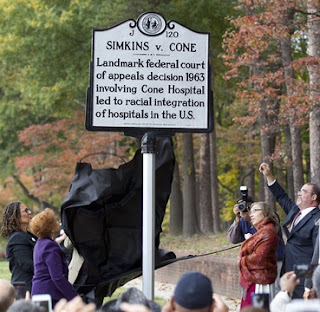 |
| Image Source: Simkins et al vs. Cone |
Topics: African Americans, Diaspora, Diversity, Diversity in Science, History, Women in Science
The scholarship gala for the Greensboro Medical Society used as its theme Egypt, specifically Imhotep, the original father of medicine, despite Hippocrates holding that distinction in the west. The presentation was to honor Dr. Otis E. Tillman, Sr., who delivered babies at then segregated hospitals in High Point, Greensboro and Winston-Salem. It was with chills that I had an epiphany: this gentle giant of medicine, who had himself endured many indignities of racism and segregation, may have delivered me at Kate Bitting Reynolds Hospital. It was possible. I didn't ask, but it did send chills to hear his clear enunciation, mental acuity and stirring story. I also met my new dentist, who I'll likely be under his care as of this posting. It was a wondrous evening.
The Greensboro Medical Society (GMS) was formed several years after the opening of L. Richardson Memorial Hospital which opened on May 4, 1927. Early accounts indicate that the society was not active during the late 1920's and 1930's. In the mid 1940's; however, the GMS was re-activated. During this time, Drs. G.H. Evans, C.C. Stewart, J.P. Sebastian, J.C. Waddy, J.R. Hawkins, W.J. Hughes, Sr., G.C. Simkins, Sr., B.W. Barnes, M.S. Jenkins, W. Murrow, and Hargraves were the physicians, dentists and pharmacists who composed the Society and staffed L. Richardson Hospital. All members were also affiliated with the Old North State Society and National Medical Association. They came together during this time for the purpose of education, fellowship, networking and socialization.
Because of the policy of segregation, which was prevalent in America during this time, these doctors were denied staff privileges at the majority hospitals and membership in the mainstream majority health professional organizations. These included the American Medical Association, American Dental Association and their regional and local affiliates. The Greensboro Medical Society therefore served as an outlet to temper the ill-effects of the isolation of these times.
After World War II, leaders in the black community were determined to improve health care for black persons by ending discrimination in hospital policies and practices. Leaders of professional organizations developed a collaborative strategy that involved the court system, federal legislation, and research and education of the public and health professionals to integrate the hospital system rather than to expand the existing separate-but-equal system. Efforts culminated in the case of Simkins v Moses H. Cone Memorial Hospital; this case became the landmark decision by the U.S. Supreme Court and led to the elimination of segregated health care.
Greensboro Medical Society, Our History
Comments